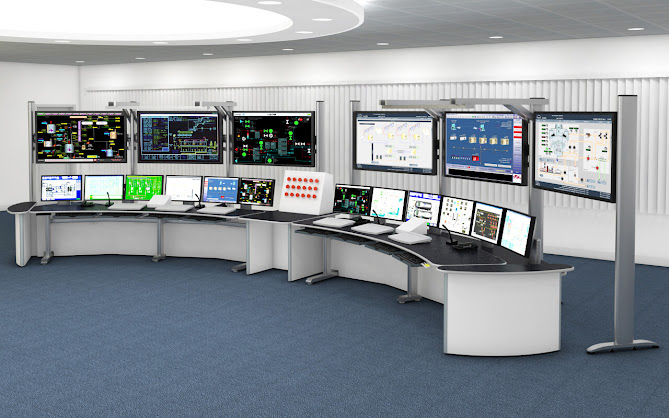Power SCADA: Enabling Reliable Power Distribution through Advanced Monitoring and Control
 |
| Power SCADA |
Power SCADA (Supervisory Control and Data Acquisition)
systems are highly specialized computer systems that enable utilities to
monitor and control entire power distribution networks from a centralized
location. At the heart of any Power SCADA system are RTUs (Remote Terminal
Units) that are installed throughout the electrical infrastructure - at
substations, transformers and other critical assets. RTUs collect real-time
data from sensors and send it back to a central control room over communication
networks.
In the control room, Power SCADA software collects all this data, analyzes
anomalies, and presents a live overview of the entire power grid on interactive
computer displays and control screens. Operators can then remotely control or
automate functions like switching circuits or changing voltage levels from the
control center. This centralized monitoring and control allows utilities to
quickly detect and address issues before they become outages or emergencies.
Monitoring the Entire Power Distribution Network
The distributed nature and scale of power grids mean they require extensive
monitoring infrastructure. Power
SCADA systems deploy thousands of RTUs throughout transmission and
distribution networks. At substations alone, RTUs can monitor hundreds of
parameters including voltage, current, power factor, circuit breaker positions
and more.
RTUs also collect environmental data critical for safety. They monitor things
like transformer temperature, oil pressure and leaks. Moreover, RTUs have input
channels that monitor switch positions on circuit breakers, breaker fail
indications and synchronizing check relay operations. This granular, real-time
visibility into grid conditions helps operators proactively manage assets and
pinpoint issues.
Data is transmitted back to the control center over various communication
channels. Originally, utilities relied on private radio networks but many are
upgrading to broadband networks due to greater capacity and reliability. Modern
systems support dual-mode communication for backup. With full network
monitoring, operators have a single-pane-of-glass view of the entire energy
delivery chain.
centralized monitoring and control enables grid automation. Remote switching
and voltage regulation reduces manual crew dispatch and speeds response times
to outages or overloads. By automating routine tasks, operators can focus on
strategic planning and exception management. This helps ensure continuous power
delivery and grid resiliency.
Analyzing Power Quality Issues
Detailed power parameter monitoring allows comprehensive power quality analysis
from a SCADA system. It detects anomalies indicating potential equipment
failures or non-technical losses. Operators can trace origins of disturbances
like sags, swells or harmonics to specific locations on the grid.
Oscillographic fault recorders capture high-resolution waveform data during
faults and disturbances. This precise fault analysis helps identify root causes
more accurately for faster remediation. Utilities often archive this data
long-term to analyze trends, validate models and improve protection
schemes/coordination over time.
Advanced power quality analytics now integrated into SCADA/EMS help identify
weak spots on the grid. They analyze historical parameter variations to
forecast looming equipment failures or grid overloads. This predictive
intelligence supports proactive maintenance to avoid unexpected outages. It
also refines long-term system planning by locating unnecessary overcapacity and
upgrading as needed.
Supporting Renewable Energy Integration
Renewable energy sources like solar and wind farms introduce variability that
challenges grid operations. Power SCADA plays a vital role enabling their
secure integration into transmission networks.
Utility SCADA monitors weather conditions and forecasts to predict renewable
generation output changes throughout the day. It detects when excess solar/wind
power may need to be curtailed to balance load. Operators can dispatch flexible
gas plants during these times.
Additionally, SCADA remotely controls the flow of renewable energy onto the
grid. It performs automated interconnections/disconnections based on network
conditions. This aids optimal renewable utilization without compromising grid
stability or overloading infrastructure not designed for two-way power flows.
Modern Power SCADA Systems
Advanced architectures continue enhancing SCADA functionality. Systems now
incorporate open communication standards, IP protocols, edge computing
capabilities and more. This evolves them into integrated IT/OT solutions called
performance management systems or modern SCADA.
Utilities are virtualizing traditional centralized systems on cloud-based
infrastructure for easier upgrades and expansion. Edge devices replace
proprietary RTUs, supporting more distributed intelligence, analytics and
autonomous controls. Meanwhile, advanced HMI/SCADA software delivers modern
visualization, augmented operations and predictive capabilities on any
endpoint.
These advanced functionalities help utilities leverage digital technologies
like AI, advanced modeling and sensors to further optimize grid reliability and
resilience in real-time for the 21st century grid. Power SCADA remains at the
heart of mission-critical monitoring and control powering communities
worldwide.
Get
more insights on Power
SCADA

%20Treatment%20(1).jpg)

Comments
Post a Comment